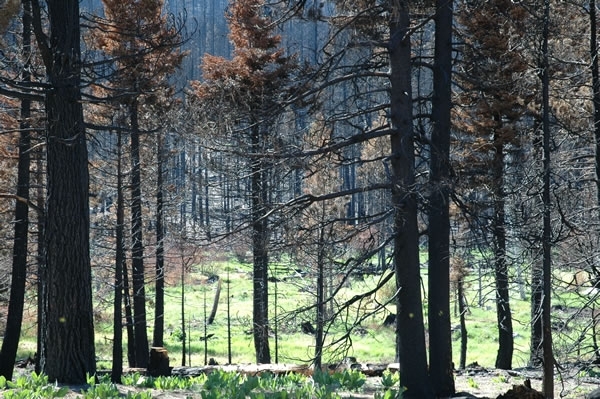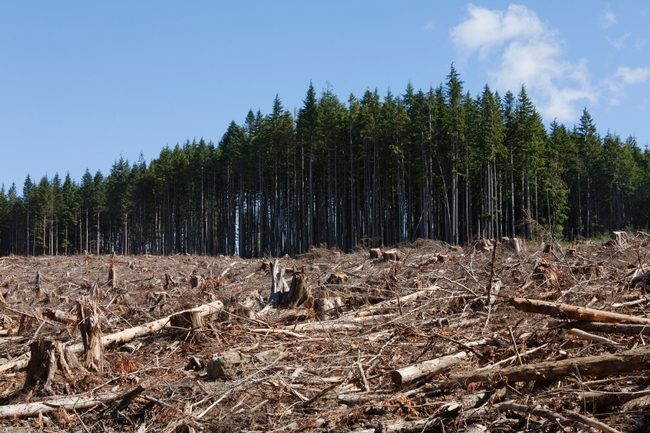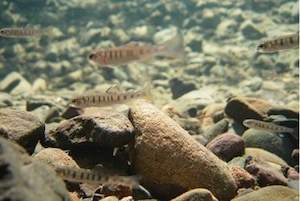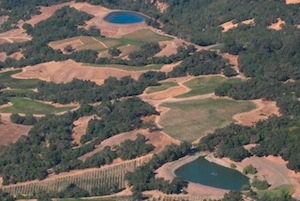UC Blogs
An Uncommon Bee
Sometimes you get lucky.While watching floral visitors foraging last week in our rock purslane (Calandrinia grandiflora), we noticed a tiny black...
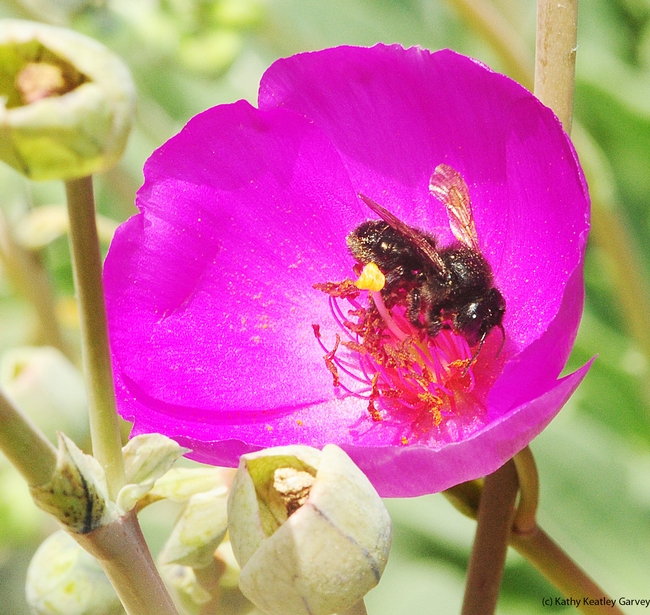
Female leafcutting bee, Megachile gemula, on rock purslane. (Photo by Kathy Keatley Garvey)
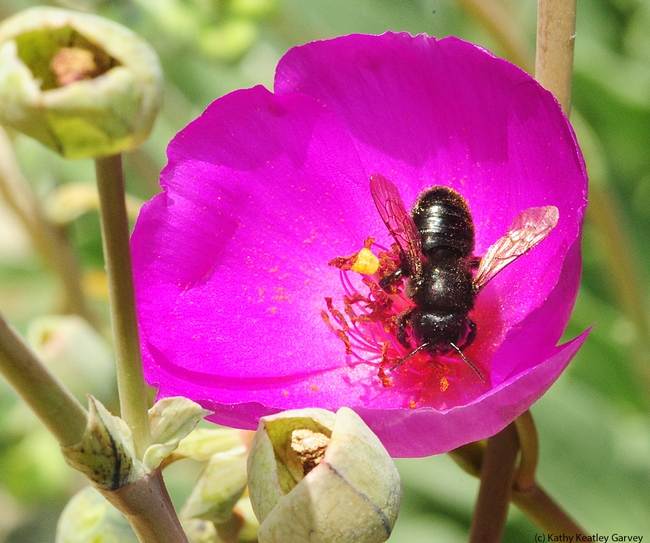
Female leafcutting bee, Megachile gemula, exiting rock purslane. (Photo by Kathy Keatley Garvey)
UCCE supports Tahoe fire awareness week and Oroville nutrition decathlon
As part of Tahoe Fire Awareness Week, May 26 to June 3, Tahoe Basin fire agencies and partners, including Tahoe Regional Planning Agency and the University of California and Nevada Cooperative Extensions, are sponsoring a series of free webinars to help individuals and communities learn how to become more fire adaptive, reported the Record-Courier. Each webinar will be held from noon to 1 p.m. and will be recorded and archived for later viewing.
“With 2012 shaping up to be a high risk year for wildfires, the more people can prepare to survive the threat the better we all will be,” said Susan Kocher, University of California Cooperative Extension advisor, natural resources.
Kocher speaks in session three of the seminar series on May 30 about defensible space landscaping. The session also includes a talk by Wendy West, UC Cooperative Extension program representative, natural resources, titled "Learning how to garden at Lake Tahoe."
See the UCCE Lake Tahoe Basin Wildfire Awareness Week website for more details and links to the webinars.
Nutrition Decathlon
UC Cooperative Extension in Butte County offers local schools a "Nutrition Decathlon," a full-day nutrition and physical activity program, reported the Oroville Mercury-Register.
UCCE is beginning its Nutrition Decathlon season, hosting activities at schools that are making changes on their campuses, said Jona Pressman, UCCE program manager, nutrition.
"To participate, they need to be making significant changes with physical activity and nutrition," Pressman said.
At Helen Wilcox School last Friday, students ran, jumped, balanced on beams, tossed balls into nets, hopped in sacks, ducked through hoops, balanced bean bags on their heads, crawled through tubes, did pushups and lifted slight weights, reported Barbara Arrigoni, Mercury-Register staff writer.
Katydid, Katy Didn't
My late father, who called me "Katydid," loved poetry.Decades after he passed, a cousin gave me a set of his books from his childhood home. One was...

Katydid on salvia. (Photo by Kathy Keatley Garvey)
When, where and how wood is used impacts carbons emissions
How wood is used after it is cleared from a forest and where that forest is located largely affects the amount of greenhouse gas emissions released into the atmosphere, according to a new study by UC Davis.
The study, published this week in the advance online edition of the journal Nature Climate Change, provides a deeper understanding of the complex global impacts of deforestation on carbon storage and greenhouse gas emissions.
When trees are felled to create solid wood products, such as lumber for housing, that wood retains much of its carbon for decades, the researchers found. In contrast, when wood is used for bioenergy or turned into pulp for paper, nearly all of its carbon is released into the atmosphere. Carbon is a major contributor to greenhouse gases.
“We found that 30 years after a forest clearing, between 0 percent and 62 percent of carbon from that forest might remain in storage,” said lead author J. Mason Earles, a doctoral student with the UC Davis Institute of Transportation Studies. “Previous models generally assumed that it was all released immediately.”
The researchers analyzed how 169 countries use harvested forests. They learned that the temperate forests found in the United States, Canada and parts of Europe are cleared primarily for use in solid wood products, while the tropical forests of the Southern Hemisphere are more often cleared for use in energy and paper production.
“Carbon stored in forests outside Europe, the USA and Canada, for example, in tropical climates such as Brazil and Indonesia, will be almost entirely lost shortly after clearance,” the study states.
The study’s findings have potential implications for biofuel incentives based on greenhouse gas emissions. For instance, if the United States decides to incentivize corn-based ethanol, less profitable crops, such as soybeans, may shift to other countries. And those countries might clear more forests to make way for the new crops. Where those countries are located and how the wood from those forests is used would affect how much carbon would be released into the atmosphere.
Earles said the study provides new information that could help inform climate models of the Intergovernmental Panel on Climate Change, the leading international body for the assessment of climate change.
“This is just one of the pieces that fit into this land-use issue,” said Earles. Land use is a driving factor of climate change. “We hope it will give climate models some concrete data on emissions factors they can use.”
In addition to Earles, the study, “Timing of carbon emissions from global forest clearance,” was co-authored by Sonia Yeh, a research scientist with the UC Davis Institute of Transportation Studies, and Kenneth E. Skog of the U.S. Department of Agriculture Forest Service.
The study was funded by the California Air Resources Board and the David and Lucile Packard Foundation.
Wine and fish for dinner? Water management required
The competition between farmers and fish for precious water in California is intensifying in wine country, say biologists at the University of California, Berkeley.
The researchers found that juvenile steelhead trout are particularly at risk during the dry summer season typical of California’s Mediterranean climate. Of the juvenile steelhead trout present in June, on average only 30 percent survived to the late summer. In years with higher rainfall and in watersheds with less vineyard land use, the survival of juvenile trout over the summer was significantly higher.
The researchers pointed out that salmon and trout conservation efforts have not adequately addressed summer stream flow. Previous studies have highlighted other limiting factors such as habitat degradation and water quality, while this study documented the importance of water quantity for restoring threatened populations.
Grantham says he is not suggesting we get rid of vineyards. “But we do need to focus our attention on water management strategies that reduce summer water use. I believe we can protect flows for fish and still have our glass of wine.”


